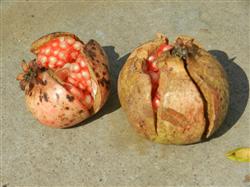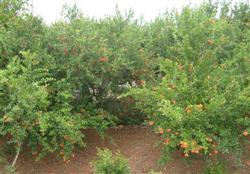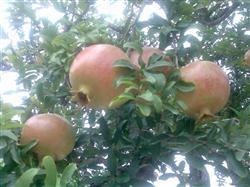Why does pomegranate crack fruit?

Why does pomegranate crack fruit? Please give the introduction and the reasons for the prevention and control of pomegranate fruit cracking: 1. Variety: pomegranate varieties under different cultivation conditions have fruit cracking phenomenon. The general maturity period is in the rainy season, the fruit is large, the pericarp is thin and smooth, the pericarp is red and white, and other varieties are easy to crack fruit. Such as Yicheng red pomegranate, Shaanxi Lintong Tianhong egg and pink sweet pomegranate. 2. Soil fertilizer: clay soil, black soil, acid and white soil, low-lying clay, more water retention, poor air permeability, not only poor fruit quality, but also easy to crack fruit. Application of nitrogen fertilizer or inorganic fertilizer over water, lack of trace elements such as Ca, K, B, serious soil erosion, soil consolidation, easy to cause fruit cracking. 3. Moisture: during maturity, the soil moisture is too large or changes too much, such as high temperature, drought, sudden rainstorm or continuous rainy days, the fruit absorbs too much water and is easy to crack. Excessive humidity in the air can also cause fruit cracking. 4. Temperature: there is a certain correlation between the change of temperature and humidity. The fruit expands rapidly in the environment of high temperature and high humidity, and it is easy to crack when the temperature drops suddenly. 5. Light: improper pruning in the growing season, partial exposure to the fruit, large temperature difference between day and night or easy to crack after rain, the crack is often sunny. 6. Growth period: fruit cracking generally occurs in the post-expansion period and ripening period (color-changing period), and the fruit cracking is more serious in case of overcast or rain or cooling. 7. Harvest: when the temperature is low in the morning or after rain, excessive harvest when ripe, collision during harvest and transportation are easy to cause fruit cracking. The cracking of pomegranate fruit is often caused by a variety of comprehensive factors, especially in the middle and later stages of pomegranate expansion, material accumulation and transformation are taking place, rapid grain expansion, large vacuole of grain plasma cells, loose structure, strong water absorption and high expansion rate. the pericarp becomes thinner gradually and the pericarp cells are small and dense. The expansion rate is small, and the fibrosis is not enough at this time, and the texture is brittle and tender. If there is a sudden rainstorm, continuous rain or cooling in the high temperature and dry season, it will cause fruit cracking. Variety is a genetic factor, which is the decisive factor of pomegranate fruit cracking, the mature pomegranate is very easy to crack, and the more cracked pomegranate grain is, the more delicious the pomegranate grain is, all kinds of birds compete to peck at each other so that the offspring of pomegranate can spread everywhere, which is also the result of natural selection. Pomegranate cracking prevention and control: 1. Variety selection: early or late-maturing varieties, medium fruit type, thick green skin, copper shell, thick pericarp, rough rust color and other qualities are not easy to crack. Such as Zaozhuang Yancheng Daqing skin, green skin rough and so on. In addition, Dahongpao is not easy to crack because of its thick pericarp. Other green-skinned pomegranates such as Huaiyuan in Anhui Province are also excellent varieties with less split fruit. 2. Soil: Yecheng pomegranate is best planted in high topography, middle and downslope on the sunny side, and deep and slightly sticky yellow loam in the upper layer. This kind of soil has good water permeability, rich mineral content, high fruit quality and not easy to split fruit. The more suitable soil quality is oil sand soil, calcareous loam and so on. 3. Fertilizer: increase the application of organic fertilizer, such as farm manure, pig manure, chicken and duck manure, green manure, etc., inorganic fertilizer with formula fertilization, little or no nitrogen fertilizer. Regular spraying of 2000ppmCaCL2 solution and appropriate amount of P, K and B elements during fruit expansion are beneficial to improve fruit quality and prevent fruit cracking. 4. Pruning: reasonable pruning during the growing period, ensuring ventilation and light transmission, strong tree potential, light spot area under the crown generally accounts for 10% of the crown projection area, 15%, and uniform light transmission. 5. Hormone treatment: spraying gibberellin (GA3) 50mg/L 2-3 times every 10-15 days can reduce the fruit cracking rate. 6. Irrigation and drainage: irrigation should be prohibited during pomegranate maturity, and timely drainage should be carried out in rainy days to prevent soil moisture from being too high. 7. Cover: the ground cover has the function of drought prevention and heat preservation. It can prevent excessive change of soil temperature, reduce temperature difference, prevent soil erosion, reduce the loss of trace elements, maintain microbial activity, increase organic matter, and make fruit cells grow evenly so as to prevent fruit cracking. The mulch has grass grass, wheat straw, green manure and so on. 8. Bagging: bagging is one of the most effective ways to prevent fruit cracking. Bagging can prevent the changes of sun, rain and sudden cold and heat of the fruit, buffer temperature and humidity, protect the fruit and prevent fruit cracking; bagging can also improve the quality of the fruit, make the pulp delicate and well colored, and prevent the infection of diseases and insect pests. Bagging is generally carried out in the young fruit stage, and the materials used can be waste newspapers, Kraft paper or sulfuric acid paper bags, or special fruit bags can be purchased directly. In addition, we should also pay attention to the control of fruit borer, such as peach borer, spray 2-3 times 20% permethrin EC 2000 times during flowering and fruit stage or use cotton ball dipped in 80% dichlorvos EC into pomegranate calyx oyster. Click to get more pomegranate tree planting techniques click to get more fruit planting techniques
- Prev

How to trim pomegranate trees in summer?
How to trim pomegranate trees in summer? Please introduce that the pruning of pomegranate trees in summer can be based on the growth characteristics of pomegranate branches. In order to maintain the absolute superiority of the growth of main branches, young trees should timely pick up, pick out and erase the over-flourishing shoots on the main branches. Fruit period tree pruning should wipe out too many sprouts in time.
- Next

How to manage the near ripening period of pomegranate fruit?
How to manage the near ripening period of pomegranate fruit? Please give guidance on the general pomegranate maturing one after another in September, and the management of the harvest period is very important. There are mainly the following aspects: first, after September, there is another peak of pomegranate fruit growth, and its growth rate is very fast compared with before. In the use of.
Related
- Moge, come on! The staff of the peasant association in the producing area of cantaloupe were frightened when the crowd gathered.
- Causes and Solutions of low Fruit setting rate of Apple
- Symptoms and control measures of passion fruit virus disease
- Fruit growing lesson: how do apple orchards keep high yields?
- Can you build orchards in the mountains? What are the pros and cons?
- How to manage the coloring period of Crisson grape?
- This paper introduces the processing technology of two kinds of fig products.
- How much is a month for retired teachers in rural areas by 2020?
- How can strawberry planting increase sugar content? We should pay attention to management in many aspects.
- What are the cultivation techniques on how to improve the yield of golden fruit?

